They say/I say – with access introduces a framework that empowers writers to engage with sources and present their ideas in a clear and compelling way. This framework provides a structured approach to accessing, integrating, and synthesizing sources, enabling writers to create well-informed and persuasive arguments.
By following the they say/I say framework, writers can navigate the complexities of academic writing with confidence. This framework guides writers through the process of finding credible sources, integrating them effectively into their writing, and avoiding plagiarism. It also emphasizes the importance of synthesizing sources to create new insights and avoid oversimplification and bias.
“They Say/I Say” Framework
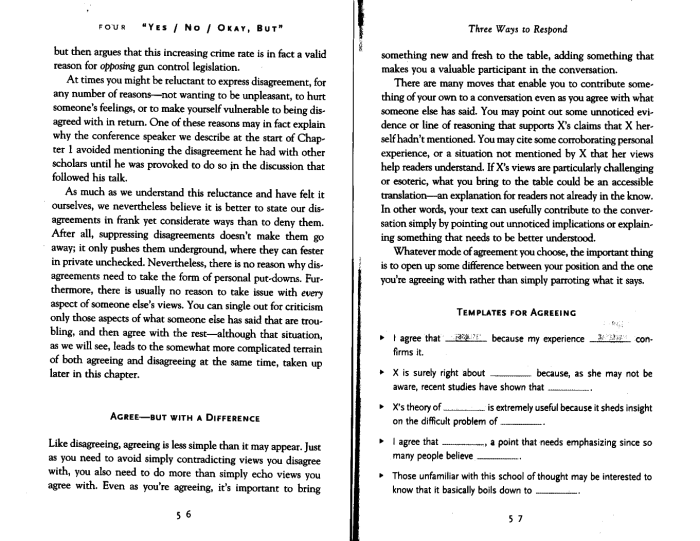
The “They Say/I Say” framework is a method for structuring academic writing by establishing a dialogue between the writer and existing scholarship. It helps writers engage with the work of others, demonstrate their understanding of the field, and develop their own arguments.
The framework consists of three main parts: the “They Say” section, the “I Say” section, and the “So What?” section. In the “They Say” section, the writer presents the views of other scholars on the topic. In the “I Say” section, the writer responds to these views, either agreeing, disagreeing, or qualifying them.
In the “So What?” section, the writer explains the significance of their argument and its implications for the field.
Benefits of Using the “They Say/I Say” Framework
- Helps writers to engage with the work of others and demonstrate their understanding of the field.
- Provides a clear and structured way to develop an argument.
- Encourages writers to think critically about the work of others and to develop their own unique perspectives.
Challenges of Using the “They Say/I Say” Framework
- Can be time-consuming to research and summarize the work of others.
- Can be difficult to write in a way that is both clear and engaging.
- Can be challenging to avoid plagiarism.
Accessing Sources
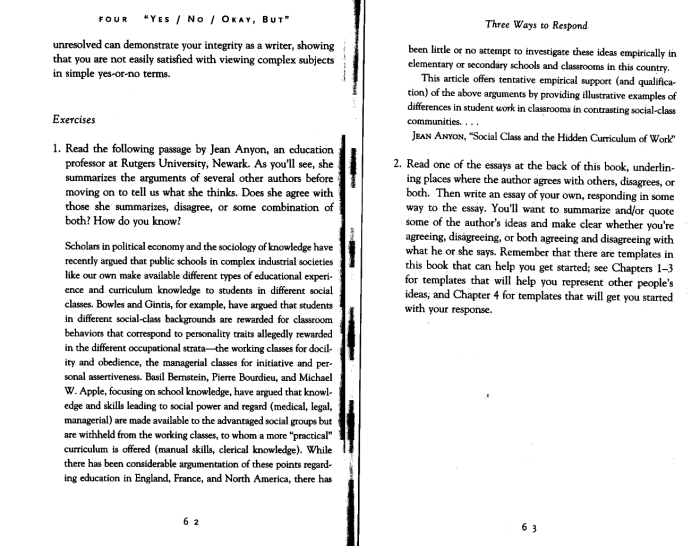
Accessing credible sources is crucial in academic writing as it ensures the reliability and accuracy of your research. Using sources that have been thoroughly researched and peer-reviewed guarantees that your work is supported by established knowledge in the field.
Finding Sources
To find credible sources, start by consulting academic databases such as JSTOR, Google Scholar, or university libraries. These databases contain a vast collection of peer-reviewed journals, books, and articles that have undergone rigorous quality control.
Evaluating Sources
Once you have identified potential sources, it is essential to evaluate their credibility. Consider the following criteria:
- Authority:Is the author an expert in the field? Is the source published by a reputable organization?
- Objectivity:Is the source free from bias or personal opinions? Does it present a balanced view of the topic?
- Currency:Is the source up-to-date and relevant to the current state of knowledge?
- Coverage:Does the source provide a comprehensive and in-depth treatment of the topic?
Ethical Implications
Using sources ethically involves properly citing and attributing the original author’s work. Plagiarism, the act of presenting someone else’s ideas as your own, is a serious academic offense. Always be transparent about the sources you use and give credit where it is due.
Integrating Sources into Writing: They Say/i Say – With Access
Integrating sources into academic writing is crucial for supporting your arguments and demonstrating the credibility of your work. By effectively incorporating sources, you can enhance the depth and authority of your writing.
There are several ways to integrate sources into your writing. You can:
- Paraphrase:Restate the source’s ideas in your own words, ensuring you maintain the original meaning.
- Summarize:Condense the main points of the source, providing a brief overview of its key arguments.
- Quote:Use the exact words from the source, enclosing them in quotation marks and citing the source properly.
It is essential to avoid plagiarism by properly citing your sources. Plagiarism occurs when you use someone else’s ideas or words without giving them proper credit. This can result in serious academic consequences. To avoid plagiarism, always cite your sources using a recognized citation style, such as MLA, APA, or Chicago.
Using Quotations and Paraphrases
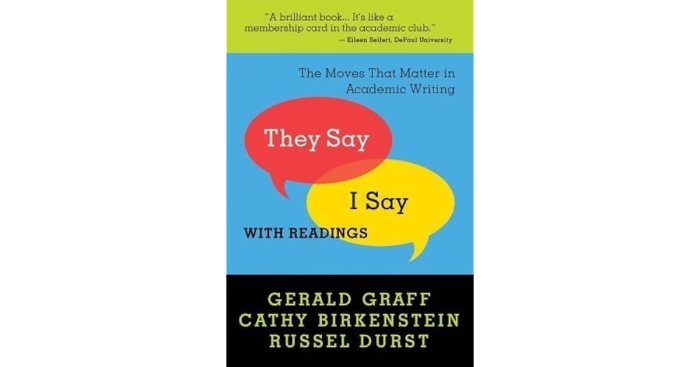
When you use sources in your writing, you have two main options: quoting directly from the source or paraphrasing the source’s ideas in your own words. Both quotations and paraphrases can be effective ways to support your arguments and add credibility to your writing, but it’s important to use them correctly.
When it comes to understanding the nuances of communication, the “they say/I say” approach emphasizes the importance of recognizing different perspectives. A prime example of this is the salutation to the dawn , a literary device that illustrates the contrast between the conventional and the unconventional.
By exploring such contrasts, the “they say/I say – with access” framework provides a valuable tool for navigating the complexities of discourse and fostering effective communication.
Quotations
A quotation is a word-for-word copy of a passage from a source. Quotations are enclosed in quotation marks and attributed to the original author. Quotations can be used to:
- Provide evidence to support your claims
- Add credibility to your writing
- Illustrate a point
When using quotations, it’s important to be accurate and to attribute the quotation to the original author. You should also only use quotations when necessary. Too many quotations can make your writing choppy and difficult to read.
Paraphrases, They say/i say – with access
A paraphrase is a restatement of a passage from a source in your own words. Paraphrases are not enclosed in quotation marks, but they should still be attributed to the original author. Paraphrases can be used to:
- Summarize a passage
- Explain a complex idea
- Provide context for a quotation
When paraphrasing, it’s important to make sure that you accurately convey the meaning of the original passage. You should also avoid plagiarizing the original passage by changing only a few words.
Synthesizing Sources
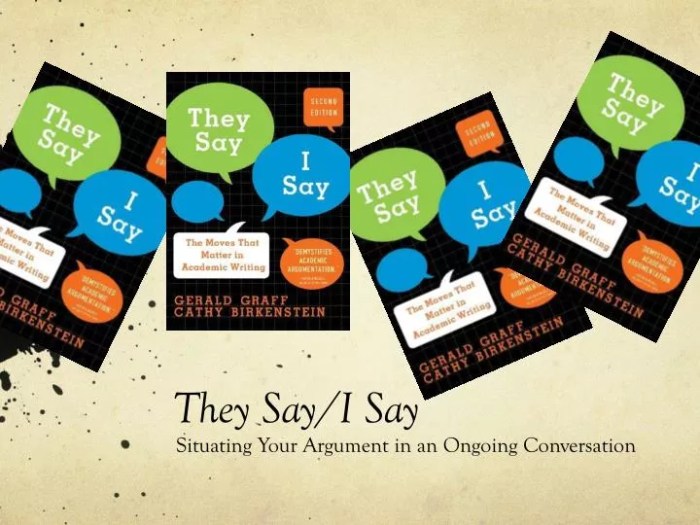
Synthesizing sources is the process of combining information from multiple sources to create new insights and understandings. It involves critically evaluating the sources, identifying commonalities and differences, and then weaving the information together to form a coherent and cohesive argument.
Strategies for Synthesizing Sources
- Identify the main points:Read each source carefully and identify the key points and arguments being made.
- Compare and contrast:Examine the similarities and differences between the sources. Consider how they support or contradict each other.
- Find common ground:Identify areas where the sources agree or overlap. These commonalities can form the foundation for your own argument.
- Fill in the gaps:Use the sources to fill in any gaps in your knowledge or understanding of the topic.
- Draw connections:Identify how the sources relate to each other and to your own ideas. This will help you develop a coherent and cohesive argument.
Importance of Avoiding Oversimplification and Bias
When synthesizing sources, it is important to avoid oversimplifying the information or introducing bias. Oversimplification occurs when you present a complex issue in a way that is too simplistic or fails to capture its nuances. Bias occurs when you present information in a way that favors one particular viewpoint or perspective.
To avoid oversimplification and bias, it is important to:
- Consider multiple perspectives:Read sources from a variety of perspectives to ensure that you are not presenting a one-sided view.
- Be aware of your own biases:Recognize your own biases and make an effort to present the information in a fair and unbiased way.
- Use precise language:Use clear and precise language to avoid confusion or misinterpretation.
- Cite your sources:Give credit to the authors of the sources you use to support your claims.
Formatting and Style
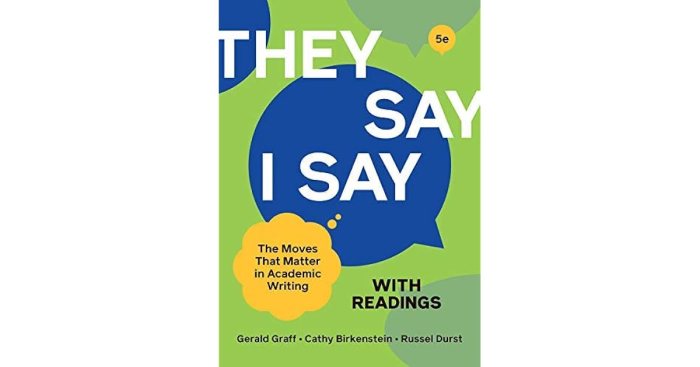
In academic writing, adhering to specific formatting and style conventions is crucial for presenting your work professionally and effectively. These conventions help maintain consistency, clarity, and organization, enabling readers to navigate your writing effortlessly.
Formatting includes elements such as font, font size, margins, and page layout. Consistency in formatting ensures a cohesive and visually appealing document. Academic writing often follows specific citation styles, such as MLA, APA, or Chicago, which provide guidelines for citing sources and formatting references.
Using a consistent citation style enhances the credibility of your work and allows readers to easily locate the sources you have consulted.
Clarity and Conciseness
Clarity and conciseness are essential elements of academic writing. Avoid using overly complex or technical language that may alienate your readers. Instead, strive for clear and concise language that effectively conveys your ideas. This means using specific and precise words, avoiding jargon, and eliminating unnecessary details.
Proofreading your work carefully before submitting it is essential to ensure accuracy and clarity. Check for any grammatical errors, spelling mistakes, or inconsistencies in formatting. A well-proofread document not only reflects your attention to detail but also enhances the overall impact of your writing.
Quick FAQs
What is the purpose of the they say/I say framework?
The they say/I say framework provides a structured approach to academic writing that emphasizes engaging with sources and presenting ideas in a clear and compelling way.
How can I find credible sources for my academic writing?
To find credible sources, consider the author’s expertise, the publisher’s reputation, the currency of the information, and the overall quality of the writing.
What are the ethical implications of using sources in academic writing?
When using sources, it is crucial to avoid plagiarism by properly citing and attributing the original author’s ideas.
What is the difference between a quotation and a paraphrase?
A quotation is a direct reproduction of the original text, while a paraphrase restates the ideas in your own words.